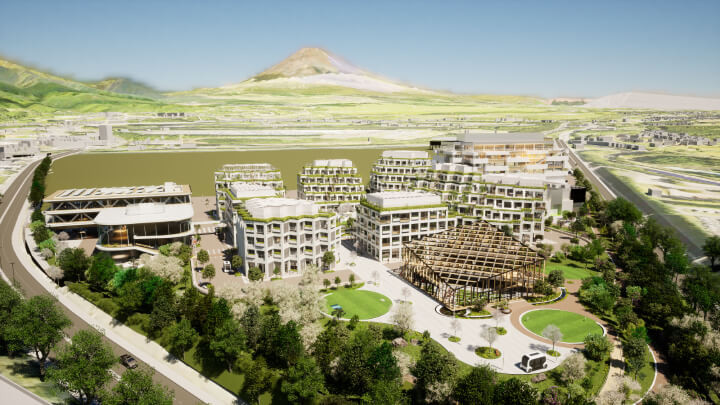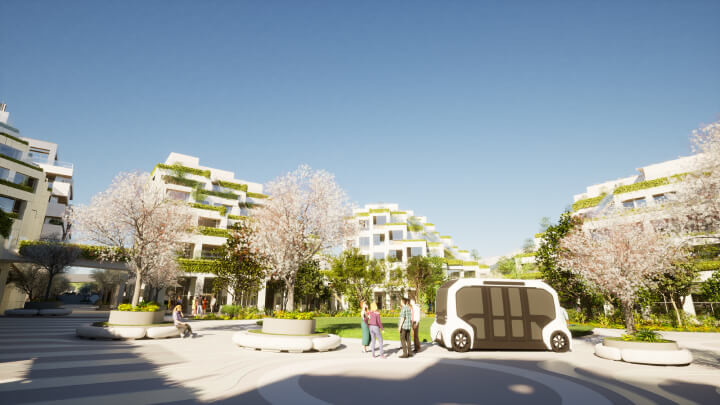Toyota's Smart City: £8 Billion Woven City's Futuristic Blueprint
Insights | 10-04-2024 | By Robin Mitchell

- Toyota's £8 Billion Investment: Toyota has announced an £8 billion investment to create Woven City, a futuristic smart city at the base of an active volcano, aiming to redefine urban living through advanced technology and sustainability.
- Integration Challenges: The article explores the complexities of integrating smart technologies into urban environments, addressing issues such as privacy, data security, and the digital divide among residents.
- Sustainability and Innovation: Woven City is designed to be a carbon-neutral ecosystem, powered by hydrogen fuel cells and featuring smart homes built with traditional Japanese techniques and modern robotics.
- Living Laboratory: As a 'living laboratory', Woven City will test autonomous vehicles, AI-driven transport systems, and a digital operating system to manage urban infrastructure, setting new standards for smart city development.
Smart cities have been promised for so many years, and while the technology to build one certainly exists, we are still yet to see a true “smart city”. While many will talk about how smart cities can exist, Toyota has recently announced that it will be spending £8 billion to build a smart city from the ground up at the base of an active volcano for the sake of experimentation. What challenges do smart cities introduce, what exactly is Toyota planning to do, and what challenges would such a project face?
What challenges do smart cities face?
The idea of smart cities is by no means an old one; people all around the world have looked at the future and tried to predict what future cities could look like. Many thought that monorails and towering skyscrapers would rise into the clouds, while others envisioned airships dominating the sky.
While cities have certainly grown, they are anything but smart despite the vast amount of technology available. With the exception of cellular communication, modern cities are not entirely different from those in the early 20th century. But why is this the case? What is it about smart cities that makes them hard to develop?
The Complex Path to Realising Smart Cities
One such issue facing smart cities is the integration of various technologies into existing urban infrastructures. Retrofitting cities with sensors, data collection devices, and interconnected systems can be a complex and costly process, requiring careful planning, coordination between different stakeholders, and significant investment to ensure that the technology functions as intended.
Privacy and data security are also major concerns when it comes to smart cities. The vast amount of data collected by sensors and surveillance systems raises questions about how this information is stored, accessed, and protected. Residents may feel uneasy about constant monitoring and the potential for their personal information to be misused or compromised, especially if such systems were exposed to outside forces.
On this note, the reliance on technology in smart cities also introduces new vulnerabilities to cyber threats and hacking. As more systems become interconnected, the risk of cyber-attacks targeting critical infrastructure, transportation networks, and public services increases. Safeguarding against these threats requires robust cybersecurity measures and continuous monitoring to detect and respond to potential breaches.
Balancing Technology and Equity in Smart Cities
Another challenge is ensuring that the benefits of smart cities are equitably distributed among all residents. There is a risk that technological advancements could widen existing social and economic disparities, creating digital divides between different communities. Access to digital services, connectivity, and information must be inclusive and accessible to all, regardless of income or background.
Furthermore, the environmental impact of smart cities must be carefully considered. While these cities aim to be sustainable and eco-friendly, the construction of new infrastructure, energy-intensive technologies, and increased resource consumption can have unintended consequences on the environment. Balancing the need for technological innovation with environmental conservation is a delicate task that requires thoughtful planning and sustainable practices.
Toyota will spend £8 billion on a city of the future
Recognising the challenges faced by smart cities, Toyota recently announced that it will be developing its own smart city from scratch for the sake of research. Toyota's ambitious project to build Woven City, a futuristic and sustainable city at the base of an active volcano, is not just a construction endeavour but a pioneering experiment in smart city development. The city, with an estimated cost of £7.8 billion, is set to become a 'living laboratory' for Toyota to test and refine their cutting-edge technologies, particularly focusing on renewable and energy-efficient self-driving vehicles known as 'E-palettes.'
The ambitious financial commitment of £8 billion by Toyota underscores the company's dedication to pioneering new forms of urban living and mobility. This investment not only covers the construction costs but also the extensive research and development needed to integrate advanced technologies such as AI-driven transport systems and smart infrastructure into the daily fabric of the city.
Bridging Innovation and Urban Sustainability in Woven City
The primary goal of Woven City is to create a seamless integration of technology into urban environments, providing a platform for Toyota to test prototypes of their autonomous vehicles. These driverless cars, equipped with sensors embedded in the infrastructure of the city, will collect invaluable data on traffic patterns, both pedestrian and vehicular, to enhance the efficiency and safety of transportation systems.
To enhance the city's innovative landscape further, Toyota plans to incorporate a comprehensive energy ecosystem powered by hydrogen fuel cells. This system aims to achieve a carbon-neutral footprint, reflecting Toyota's commitment to environmental sustainability and cutting-edge technology deployment in urban settings.

Woven City is also designed to be a sustainable and eco-friendly habitat, with a significant emphasis on reducing emissions by utilising hydrogen to power 'smart homes.' These homes, along with many of the city's buildings, will be constructed using traditional Japanese architectural styles, incorporating wood and artisanal techniques. Despite the traditional approach to construction, the heavy labour involved will be carried out by robots programmed specifically for this purpose, showcasing the fusion of traditional craftsmanship with modern technology.
Toyota's president, Akio Toyoda, envisions Woven City as a digital ecosystem where people, buildings, and vehicles are interconnected through data and sensors. This interconnectedness will enable the testing of connected AI technology in both virtual and physical realms, allowing for the maximisation of its potential in real-world scenarios.
A Visual Journey into Toyota's Futuristic Woven City
To visually capture the essence and innovative spirit of Woven City, Toyota has released a concept video that showcases the futuristic technologies and sustainable practices being integrated into the city's design. This video provides a vivid illustration of how Woven City aims to redefine urban living. Watch the concept video below to see Toyota's vision in action:
Akio Toyoda, Toyota's president, has emphasised the transformative potential of Woven City as a 'living laboratory'. Here, every element from buildings to vehicles to public spaces is part of an integrated experiment in sustainable and smart urban design. This holistic approach is expected to yield insights that could shape the future of urban living worldwide.
The project represents a unique opportunity for Toyota to develop a digital operating system that will manage the city's infrastructure efficiently. By creating a city from the ground up, Toyota aims to explore the possibilities of connected technologies in enhancing urban living. The seamless communication between various elements within the city, facilitated by data and sensors, will pave the way for innovative solutions that can be applied on a larger scale in the future.
Challenges and Future Prospects of Toyota's Woven City
While Toyota's Woven City project presents an exciting vision of a futuristic and sustainable urban environment, it also faces several challenges and considerations as it moves forward. The innovative features and technologies integrated into the city raise important questions about privacy, security, sustainability, and the broader implications of such a project.
One of the primary challenges that Toyota's Woven City will face is ensuring the privacy and security of its residents. With interconnected systems, data collection devices, and sensors embedded throughout the city, there is a risk of potential data breaches, surveillance concerns, and unauthorised access to personal information. Safeguarding against cyber threats and ensuring data protection will be crucial to maintaining the trust and well-being of the residents.
The environmental impact of the city must be carefully managed to ensure its sustainability. While the focus on renewable energy sources and eco-friendly practices is commendable, the construction process, energy consumption, waste management, and resource utilization all need to be monitored and optimised to minimise the city's carbon footprint and ecological impact. Balancing technological advancements with environmental conservation will be essential for the long-term viability of Woven City.
Looking ahead, the success of Toyota's Woven City could pave the way for future smart city initiatives and urban development projects. By serving as a testbed for cutting-edge technologies, digital infrastructure, and sustainable practices, Woven City has the potential to inspire similar projects around the world. The lessons learned from this experiment could shape the future of urban planning, transportation systems, energy management, and community living.

